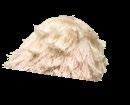
South
Potteric Carr
Potteric’s woodlands are enchanted with folkloric witch’s hats, woolly milkcaps, earth stars, birds nest fungi, shaggy parasols and poison pies. Potteric is also home to a very rare fungus, known only as Allopsalliota geesterani. This fungus is recorded in just one other UK location (in Norfolk) and we believe the spores came here via the main railway line. If you’d like to learn more about Potteric’s fungi, join us on one of our fungi forays in the autumn!

Dearne Valley Country Park
Gnarly and otherworldly Cliffe Wood inside the reserve is an ancient woodland of oak and silver birch – and a good place to look for more unusual varieties of mushrooms. Striking amethyst deceivers have been spotted here; As you might expect from the name, they’re violet in colour, like amethyst crystals.
Fen Carr
This floodplain meadow is packed with plants throughout the year – and grassland fungi! See if you can spot the spongy pale bolete and the blue-lilac tinged wood blewit.

East
North Cliffe Wood
Jewelled carpets of bluebells in this beautifully varied woodland in spring give way to tinier and more delicate autumnal delights. The petite lilac wood blewit is not to be missed –look out too for the tiny candlesnuff fungus, which resembles a snuffed-out candle wick and releases whisps of ‘spores’ when disturbed.

Pearson Park Wildlife Garden
Nestled in the centre of Hull, this wild gem is a great place to spot some more unusual urban fungi - including snowy waxcap, willow shield and the distinctive dead moll’s fingers, a daintier relative of the grisly dead man’s fingers fungus!
Allerthorpe Common
A mixture of heath, grassland and woodland makes for good conditions for fungi to thrive. Enjoy clusters of fly agaric springing up – don’t step in any circles! – alongside ochre brittle gill and witches butter. Witches’ butter is a striking fungus to spot on fallen or dying branches; it has a jelly-like texture and is yellow and frilly in shape, and can go from being dry and shrivelled to rehydrated after periods of rain.
West
Adel Dam
Enjoy the woodland floor lit up in a festival of fungi, with the bright scarlet elf cup and yellow sulphur tuft contrasting the more camouflaged hoof fungus and sheathed woodtuft on stumps of wood. The hoof fungus is also known as the tinder fungus because the inner fibres can be used as tinder to start fires. Evidence of hoof fungus was found in the ice body Otzi’s belongings!

Stoneycliffe Wood
A walk along the meandering beck trickling through this ancient woodland site will bear a fantastic display of fly agaric, false death caps and the very special old man of the woods. The old man of the woods is perfectly camouflaged as rotting pine cones or leaf litter with its very shaggy textured cap, making it a rare find.
Hetchell Wood
In autumn Hetchell Wood becomes a riot of colour, falling burnished autumn leaves mixed with plenty of fantastic fungi –including common puffballs, amethyst deceivers and elfcups. Follow the winding paths to see what you can spot!

North
Little Beck Wood
This characterful woodland is full of fungi like turkey tail, oak bug milkcap, common stinkhorn and a variety of delicate-looking bonnets, nestled in amongst the autumn leaves. Follow the Cleveland trail to spot more fungi!
Strensall Common


Popping out from amongst the heath scrub and spindly birch clusters, enjoy fungi like the birch polypore – used to sharpen knives – and fly agaric, the brightly-coloured, eye-catching mushroom known as the classic ‘fairytale’ toadstool.
Barlow Common
A brownfield site now flourishing with a mixture of meadow and woodland, Barlow is a great place to spot some unusual fungi like the white saddle and vinegar cup, which catapult their mature spores into the air in puffs of white dust. Keep an eye out for the unique and beautiful shaggy inkcap, which appears to drip with black ink, topped by a lawyer’s wig!


Did you know that we care for over 100 nature reserves across Yorkshire? Plan your next wild adventure at ywt.org.uk/nature-reserves
Our members make a real and lasting difference for Yorkshire’s wildlife and wild places. Please join us today!
When you join us, you’ll enjoy:
n Unlimited free admission and parking at our visitor centres
n A subscription to our quarterly Wildlife Yorkshire magazine
n Discounts on some of our unforgettable wild events
n Invitations to exclusive experiences and more!

Plus when you pay by monthly Direct Debit, we’ll also send you a FREE copy of Discover Yorkshire’s Wildlife worth £14.99 - the most comprehensive guide to where, when and how to see wildlife in Yorkshire! JOIN US

